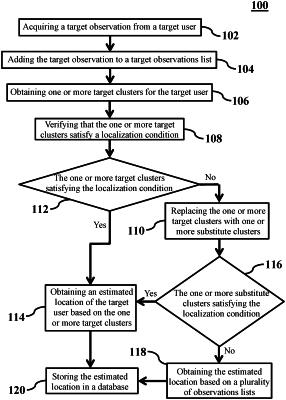| CPC H04W 48/16 (2013.01) [H04B 17/318 (2015.01); H04L 41/16 (2013.01); H04W 64/003 (2013.01); H04W 88/10 (2013.01); H04W 88/12 (2013.01)] | 20 Claims |

|
1. A method for indoor localization based on previous activities, the method comprising:
acquiring, utilizing a respective access point (AP) of a plurality of APs, a target observation from a target user of a plurality of users;
adding, utilizing one or more processors, the target observation to a target observations list of a plurality of observations lists associated with the plurality of users, the target observations list comprising a plurality of observations associated with the target user;
obtaining, utilizing the one or more processors, one or more target clusters of a plurality of clusters for the target user based on the plurality of observations, each of the plurality of clusters associated with a respective user of the plurality of users;
verifying, utilizing the one or more processors, that the one or more target clusters satisfy a localization condition;
replacing, utilizing the one or more processors, the one or more target clusters with one or more substitute clusters of the plurality of clusters responsive to the one or more target clusters not satisfying the localization condition, the one or more substitute clusters associated with one or more substitute users of the plurality of users, the one or more substitute users different from the target user;
localizing, utilizing the one or more processors, the target user by obtaining an estimated location of the target user based on the one or more target clusters responsive to the one or more target clusters satisfying the localization condition;
localizing, utilizing the one or more processors, the target user by obtaining the estimated location of the target user based on the plurality of observations lists responsive to the one or more substitute clusters not satisfying the localization condition; and
storing, utilizing the one or more processors, the estimated location in a database.
|